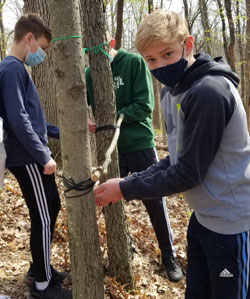Forest Hills — Myla Morey and Micah Scholtens are familiar with the wooded area next to Central Middle School.
Myla, an eighth-grader, has explored the space during outdoor lessons before, once in a simulated crime-of-nature-scene to learn about the importance of conservation. Micah, who is in seventh grade, has ridden his bike on the trails.
Now, both know the area as home to some invasive plant species, as well as the site of an art installation they helped to create.
About 140 students in Lea Sevigny’s natural expressions class and art teacher Caitlyn Tetreault’s draw, paint and print class came together recently for about three weeks to create the outdoor art exhibit with a purpose.

The wooded area east of the building that is often traversed by neighbors and students is being taken over by invasive plants, including garlic mustard, autumn olive and, most drastically, Oriental bittersweet, an aggressive, woody vine that can twine up to 90 feet and choke out even mature trees.
Seventh- and eighth-graders at the school first trimmed the invasive plants to make looms, on which they weaved material from the invasives themselves, fiber scraps and upcycled materials such as fabric and string.
The aim: to raise awareness of invasive species in general, and specifically, of the presence of bittersweet on private and public lands in the Ada/Cascade area.
A website that explains the project includes a walking tour map so community members can view the art, as well as artist statements for each piece that explain how the project came to be and what they tried to convey.
For a piece titled “Chaos Overtaken,” for example, students Anneke Anglin, Bella Wolbert, Gretchen Riedel, Keira Digennaro, Eileen Zhan and Toby Cameron intertwined Oriental bittersweet and garlic mustard into their work, along with candy wrappers, string and T-shirt scraps. “This weaving project has allowed us to understand the dangers of invasive plants, but we also learned about upcycling and how to use it in our work,” they wrote.
For another art piece, titled “What’s In Our Woods,” students Henry McNamara, Jakob Terpstra, Braedon Rozema and Matthew Sexton incorporated the item perhaps most emblematic of the year, a face mask. In their statement, they wrote, “By showing what’s in our woods people will have to get rid of it to make our woods clean. We bring awareness to littering, and how we can repurpose things to help the environment, and make our woods better by getting rid of invasive species.”
Lesson Learned
Micah was a student at the district’s Goodwillie Environmental School, and said he had some knowledge of invasive plants. “But I hadn’t really heard about Oriental bittersweet,” he said. “Once you know what it is, you can really see that it’s all over.”
Myla said the bittersweet sometimes twines with itself and with poison ivy, and that it is more difficult to pull its roots out of the ground. She said she used clippers to remove vines from around trees that were then used to construct student looms.
Myla said placing the vertical “warp strings” for her group’s 5-foot piece was most challenging, because the vines used for the strings don’t grow perfectly straight. For Micah, the most challenging part of the process was the weaving. His group of six classmates spent about six class periods creating their art.
And, Micah admits, the experience has made him vigilant about invasives.
“I was actually outside on my trampoline the other day and I noticed some hanging from a tree. So I got down and was able to pull it down,” he recalled.

Community Partners and a Compost No-no
Sevigny said the idea for the project came about organically, as most outdoor learning ideas do. The pair of teachers took a walk through the woods, talking about how they could collaborate on outdoor learning. The subject of invasive species came up — “We couldn’t not talk about (bittersweet), because it is all over,” she said — and one thing led to another.
The project also hit on a number of curriculum standards. Among them were the use of art materials and craftsmanship, honing specific communication skills, problem-solving and learning about and addressing human-caused environmental problems.
The artwork is expected to be displayed in the wooded area through the end of the school year.
Sevigny said the project also utilized community partners. They received support and garden tools from Groundswell, guidance from Revery landscape architecture and input from John Despres, a scenic artist and Sevigny’s husband, who advised students how to attach looms to trees, demonstrated technique and donated materials.
“We’re proud of the work the students accomplished, the learning that took place and the creativity of the materials they used,” she said. “Mostly, we’re encouraged by the positive impact students were able to make on the forest in regards to removing invasive (plants) and planting/encouraging native species.”
Sevigny said most people don’t realize it when they see Oriental bittersweet “because it just looks green… but it kills trees and pulls them down. It just doesn’t stop growing.”
Seeing the vine’s leaves and bright-colored berries incorporated into wreaths sold at farm markets, is, well, bittersweet, she said.
“They are extremely easy to spread by that seed,” Sevigny said. “People need to know they shouldn’t just throw them on the compost pile. That’s why we have to get the word out.”















